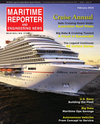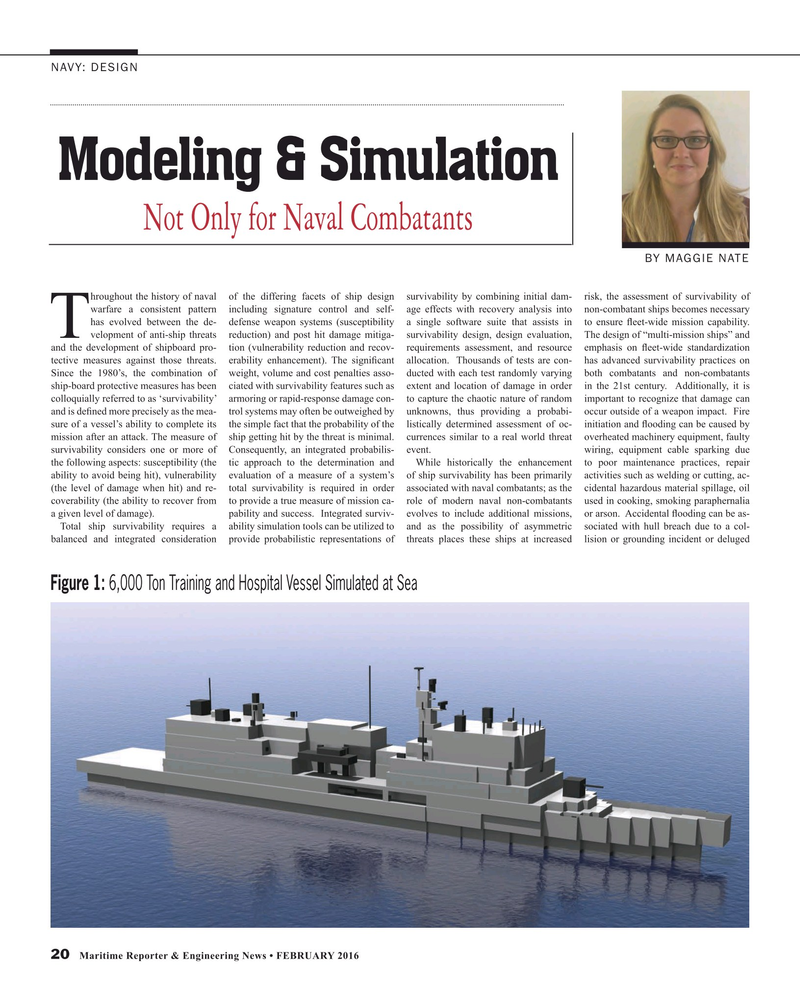
Page 20: of Maritime Reporter Magazine (February 2016)
Cruise Ship Technology Edition
Read this page in Pdf, Flash or Html5 edition of February 2016 Maritime Reporter Magazine
NAVY: DESIGN
Modeling & Simulation
Not Only for Naval Combatants
BY MAGGIE NATE hroughout the history of naval of the differing facets of ship design survivability by combining initial dam- risk, the assessment of survivability of warfare a consistent pattern including signature control and self- age effects with recovery analysis into non-combatant ships becomes necessary has evolved between the de- defense weapon systems (susceptibility a single software suite that assists in to ensure ? eet-wide mission capability.
Tvelopment of anti-ship threats reduction) and post hit damage mitiga- survivability design, design evaluation, The design of “multi-mission ships” and and the development of shipboard pro- tion (vulnerability reduction and recov- requirements assessment, and resource emphasis on ? eet-wide standardization tective measures against those threats. erability enhancement). The signi? cant allocation. Thousands of tests are con- has advanced survivability practices on
Since the 1980’s, the combination of weight, volume and cost penalties asso- ducted with each test randomly varying both combatants and non-combatants ship-board protective measures has been ciated with survivability features such as extent and location of damage in order in the 21st century. Additionally, it is colloquially referred to as ‘survivability’ armoring or rapid-response damage con- to capture the chaotic nature of random important to recognize that damage can and is de? ned more precisely as the mea- trol systems may often be outweighed by unknowns, thus providing a probabi- occur outside of a weapon impact. Fire sure of a vessel’s ability to complete its the simple fact that the probability of the listically determined assessment of oc- initiation and ? ooding can be caused by mission after an attack. The measure of ship getting hit by the threat is minimal. currences similar to a real world threat overheated machinery equipment, faulty survivability considers one or more of Consequently, an integrated probabilis- event. wiring, equipment cable sparking due the following aspects: susceptibility (the tic approach to the determination and While historically the enhancement to poor maintenance practices, repair ability to avoid being hit), vulnerability evaluation of a measure of a system’s of ship survivability has been primarily activities such as welding or cutting, ac- (the level of damage when hit) and re- total survivability is required in order associated with naval combatants; as the cidental hazardous material spillage, oil coverability (the ability to recover from to provide a true measure of mission ca- role of modern naval non-combatants used in cooking, smoking paraphernalia a given level of damage). pability and success. Integrated surviv- evolves to include additional missions, or arson. Accidental ? ooding can be as-
Total ship survivability requires a ability simulation tools can be utilized to and as the possibility of asymmetric sociated with hull breach due to a col- balanced and integrated consideration provide probabilistic representations of threats places these ships at increased lision or grounding incident or deluged
Figure 1: 6,000 Ton Training and Hospital Vessel Simulated at Sea 20 Maritime Reporter & Engineering News • FEBRUARY 2016
MR #2 (18-25).indd 20 2/3/2016 10:22:07 AM

 19
19

 21
21
